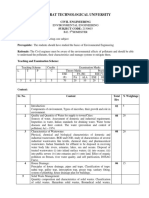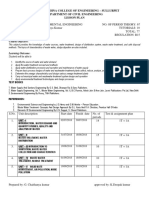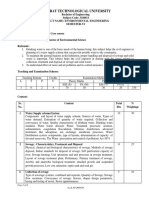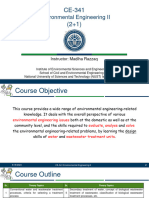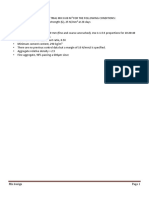Introduction To Phe III and Course Content-1
Uploaded by
Amos kiprutoIntroduction To Phe III and Course Content-1
Uploaded by
Amos kiprutoTechnical University of Mombasa
ECV 4506: PUBLIC HEALTH ENGINEERING III
(PHE III)
Lecturer : Meshack Saboke
Email : msaboke@tum.ac.ke
GENERAL INTRODUCTION TO THE UNIT
In Public Health Engineering II (PHE II) you covered collection of sewage,
conveyance to a central treatment plant and different methods of treating the same.
This is the conventional way of safely handling sewage. However, it is not possible
to have conventional sewerage systems in all towns and rural areas. It is for this
reason that you need to learn on the alternative forms of sanitation which will serve
those areas that for one reason or another cannot be covered by conventional
sewerage system either as individual households or small communities. You will
cover these alternative forms of sanitation as well as treatment and disposal of
sewage sludge in this Unit.
Sewage is basically the liquid wastes generated in a community but in addition solid
and gaseous wastes are also generated. If solid waste is not properly handled and
safely disposed – it can pose a public health problem and environmental pollution.
You will therefore also learn solid waste collection and disposal methods in this
Unit. Other topics which will be covered in this Unit include adsorption isotherms
and reuse of sewage and industrial effluents.
Course Description
Session One: Alternative forms of sanitation
TUM is ISO 9001:2015 Certified
1
Various forms of alternative sanitation – which include Pit Latrines, Improved
Pit Latrines and Ecological Sanitation (Ecosan). Advantages and
disadvantages of using these forms of sanitation. Septic tank is one of the
alternative forms of sanitation but will be dealt wit h in the next session.
Session Two: Septic Tank
Definition, design parameters and design of a septic tank. Safe disposal of
septic tank effluent.
Session Three: Treatment of Sewage Sludge
Definition, sources and characteristics of sewage sludge. Preliminary
operations in sludge treatment, treatment and conditioning of sewage sludge.
Session Four: Dewatering and disposal of Treated Sludge
Methods of sludge dewatering – natural evaporation, percolation and using
mechanical dewatering devices. Sludge disposal methods – spreading on land,
lagooning, dumping and landfilling.
Session Five: Tutorial and Assignment I
Design of a septic tank and Calculation of specific gravity of sludge. Give
students examinable assignment for submission.
Session Six: Industrial Wastewater
Importance of industrial wastewater treatment. Pollution of natural resources in
particular and environment in general by industrial wastes. Industrial effluent
standard for disposal – into streams, on land and into municipal sewers.
Treatment of industrial wastewater.
Session Seven: Wastewater from specific industries.
Dairy, meat, canning, Breweries, Pharmaceutical, Tannery, paper and
radioactive industries.
Session Eight: Assignment II and CAT I
TUM is ISO 9001:2015 Certified
2
Session Nine: Visit to a Wastewater Treatment Plant
Visit to Kipevu Wastewater Treatment Plant. Demonstration of physical,
Chemical and biological treatment of wastewater. Demonstration of sludge
treatment and disposal at the treatment plant.
Session Ten: Solid waste collection.
Definition of various types of solid waste. Separation of refuse and storage bins.
Organization of refuse collection – frequency of collection, equipment, teams,
routes, cost and records.
Session Eleven: Methods of Solid
waste disposal
Methods of solid waste disposal – dumping into the sea, sanitary landfill,
compositing, ploughing in fields, hog feeding, incineration, grinding and
discharging into municipal sewers, salvaging and biological digestion.
Session Twelve: Adsorption and CAT II
Definition and terms used in adsorption. Factors that affect the rate of
adsorption and adsorption equilibrium. Definition of adsorption isotherm.
Practical application of adsorption in engineering.
Learning Outcomes
By the end of this course the student will be able to:
i. Construct waste treatment and disposal systems for individual
households and small communities
ii. Undertake treatment of sewage sludge and unit processes of waste water
and
iii. Explain adsorption Isotherms and their practical application in
engineering
iv. Demonstrate understanding of Solid waste collection principles and
disposal methods.
TUM is ISO 9001:2015 Certified
3
Mode of Study
This course will adopt a blended learning format which essentially consists of online
learning modules where a portion of the lecture and reading material will be presented
through videos, text, and interactive programming exercises.
Assessment
There will be two forms of evaluation: There will be student activities in form of
assignments, written CATs and written exam to be taken as per the university
academic policy.
The weight for each form of assessment are:
Type of Assessment Weight
Continuous Assessment (assignments, Quizes, written CATs) 30%
Written Examination 70%
Total 100%
Reference materials
i. Text Books
Eddy, M., Tchobanoglous, G. and Stensel, D., H. (2013). Wastewater
Engineering: Treatment and Resource Recovery, 2048 p, 5th Edition, Published
by McGraw-Hill Education, ISBN-10: 0073401188,
Mackenzie, D. and Cornwell, D. (2012). Introduction to Environmental
Engineering, Published by McGraw-Hill Education, ISBN-10: 0073401145,
ISBN-13: 978-0073401140.
Crittenden, J., Rhodes, R., T. and Hand, D., W., Howe, K. and Tchobanoglous, G.
(2012). Water treatment: Principles and Design, Published by John Wiley and
Sons, ISBN – 10: 0470405392, ISBN – 13: 978- 0470405390.
ii. Journals
Journal of Water and Wastewater Engineering, ISSN 1002-8471.
Journal of Environmental Engineering and Science, ISSN 1496-2551(Print),
ISSN 1496-256X (Online).
TUM is ISO 9001:2015 Certified
4
Journal of Waste Water Treatment, ISSN 2472-0518
TUM is ISO 9001:2015 Certified
5
You might also like
- ES 307 Lectures Autumn 2023 - ALL Slides Till MidSemNo ratings yetES 307 Lectures Autumn 2023 - ALL Slides Till MidSem187 pages
- Gujarat Technological University: Environmental Engineering B.E. 5 SemesterNo ratings yetGujarat Technological University: Environmental Engineering B.E. 5 Semester4 pages
- Gujarat Technological University: Water & Waste Water Engineering 2160604No ratings yetGujarat Technological University: Water & Waste Water Engineering 21606044 pages
- Wastewater Engineering Cource Guide BookNo ratings yetWastewater Engineering Cource Guide Book4 pages
- BE Civil Syllabus2008Course - 19.042018 PDFNo ratings yetBE Civil Syllabus2008Course - 19.042018 PDF118 pages
- Che 190 MTH Course Outline Course Logistics Schedule Topics & Class Activities SubmissionNo ratings yetChe 190 MTH Course Outline Course Logistics Schedule Topics & Class Activities Submission3 pages
- PG M.tech Course Struc - and Syllabus (Ee-Ce)No ratings yetPG M.tech Course Struc - and Syllabus (Ee-Ce)18 pages
- Course Contents Environmental Engineering - IINo ratings yetCourse Contents Environmental Engineering - II6 pages
- GCKR Ee - 1 Gokula Krishna College of EngineeringNo ratings yetGCKR Ee - 1 Gokula Krishna College of Engineering6 pages
- Guru Nanak Dev Engineering College, LudhianaNo ratings yetGuru Nanak Dev Engineering College, Ludhiana17 pages
- CIVL375: Water and Wastewater TechnologyNo ratings yetCIVL375: Water and Wastewater Technology3 pages
- Gujarat Technological University: Page 1 of 4No ratings yetGujarat Technological University: Page 1 of 44 pages
- Introduction Do Environmental Engineering CIVI 6611: INSTRUCTOR: Maria Elektorowicz, PH.D., Ing., FCSCENo ratings yetIntroduction Do Environmental Engineering CIVI 6611: INSTRUCTOR: Maria Elektorowicz, PH.D., Ing., FCSCE3 pages
- icya-3408-tratamiento-de-aguas-residuales (2)No ratings yeticya-3408-tratamiento-de-aguas-residuales (2)4 pages
- KANNUR UNIVERSITY BTech.S7 CE SyllabusNo ratings yetKANNUR UNIVERSITY BTech.S7 CE Syllabus15 pages
- Environmental Engineering Workbook (Gate Ac)No ratings yetEnvironmental Engineering Workbook (Gate Ac)78 pages
- Environmental Engg. - Pollution ControlNo ratings yetEnvironmental Engg. - Pollution Control198 pages
- Duratio Nof Exam in Hours Marks For Total Marks Practical/ Field Work/ Assignmen T IA ExamNo ratings yetDuratio Nof Exam in Hours Marks For Total Marks Practical/ Field Work/ Assignmen T IA Exam24 pages
- Environmental Engineering -II Lecture 0No ratings yetEnvironmental Engineering -II Lecture 014 pages
- Key Questions in Environmental Toxicology: A Study and Revision GuideFrom EverandKey Questions in Environmental Toxicology: A Study and Revision GuideNo ratings yet
- Gujarat Technological University: Page 1 of 3No ratings yetGujarat Technological University: Page 1 of 33 pages
- National Institute of Technology: Teaching Scheme and Complete SyllabusNo ratings yetNational Institute of Technology: Teaching Scheme and Complete Syllabus19 pages
- ECV 4504 - Water Resources Engineering INo ratings yetECV 4504 - Water Resources Engineering I7 pages
- Flow Chart On Elements of Sanitary EngineeringNo ratings yetFlow Chart On Elements of Sanitary Engineering2 pages
- ES 307 Lectures Autumn 2023 - ALL Slides Till MidSemES 307 Lectures Autumn 2023 - ALL Slides Till MidSem
- Gujarat Technological University: Environmental Engineering B.E. 5 SemesterGujarat Technological University: Environmental Engineering B.E. 5 Semester
- Gujarat Technological University: Water & Waste Water Engineering 2160604Gujarat Technological University: Water & Waste Water Engineering 2160604
- Che 190 MTH Course Outline Course Logistics Schedule Topics & Class Activities SubmissionChe 190 MTH Course Outline Course Logistics Schedule Topics & Class Activities Submission
- Introduction Do Environmental Engineering CIVI 6611: INSTRUCTOR: Maria Elektorowicz, PH.D., Ing., FCSCEIntroduction Do Environmental Engineering CIVI 6611: INSTRUCTOR: Maria Elektorowicz, PH.D., Ing., FCSCE
- Duratio Nof Exam in Hours Marks For Total Marks Practical/ Field Work/ Assignmen T IA ExamDuratio Nof Exam in Hours Marks For Total Marks Practical/ Field Work/ Assignmen T IA Exam
- Key Questions in Environmental Toxicology: A Study and Revision GuideFrom EverandKey Questions in Environmental Toxicology: A Study and Revision Guide
- National Institute of Technology: Teaching Scheme and Complete SyllabusNational Institute of Technology: Teaching Scheme and Complete Syllabus



